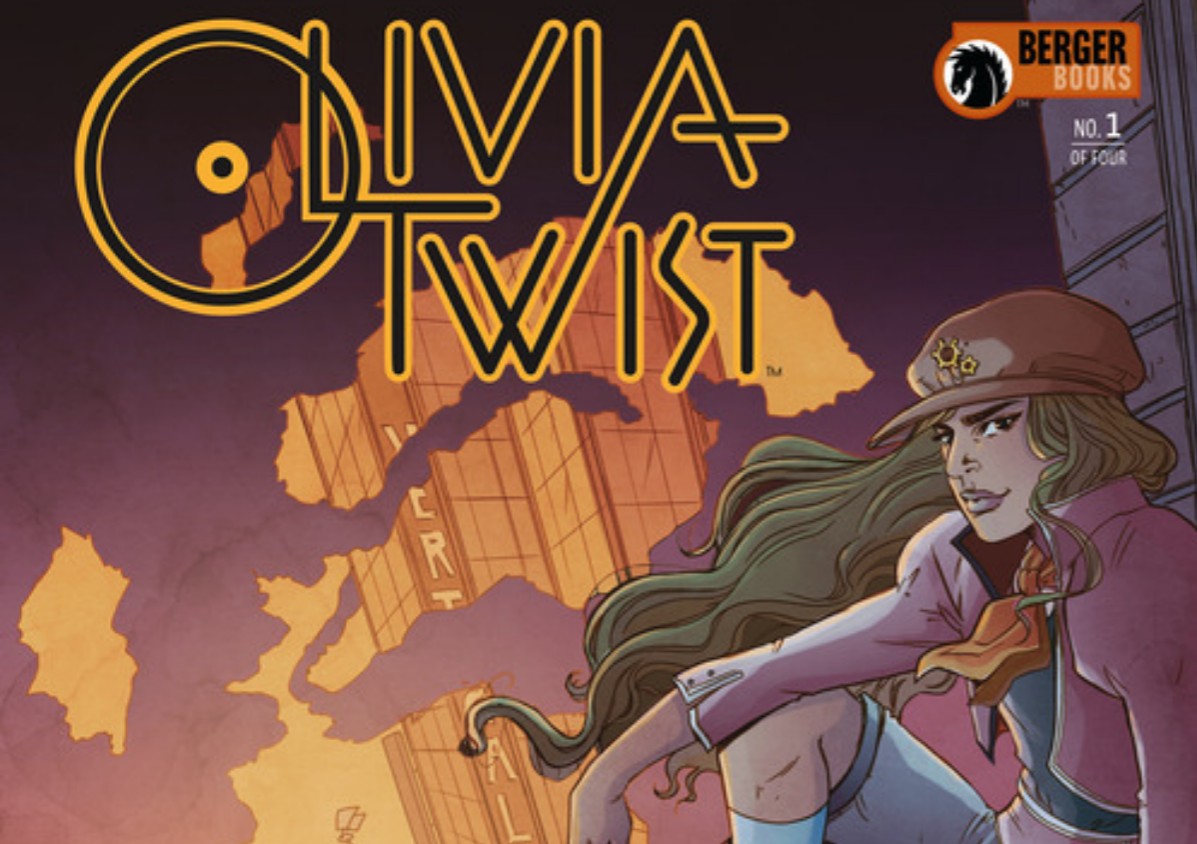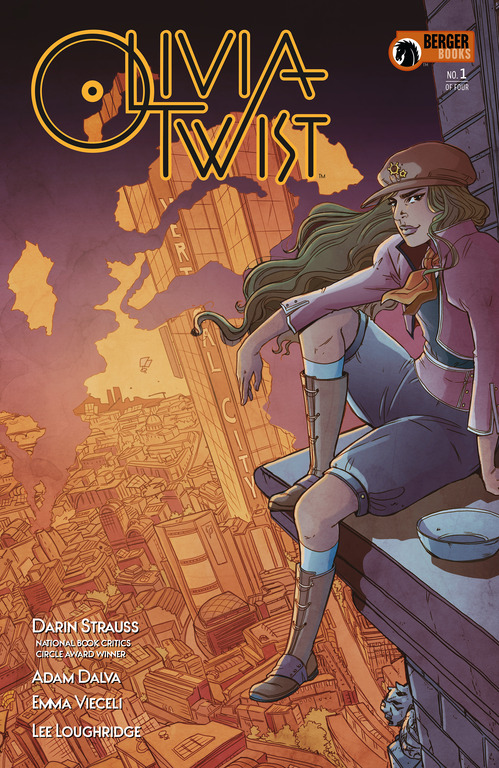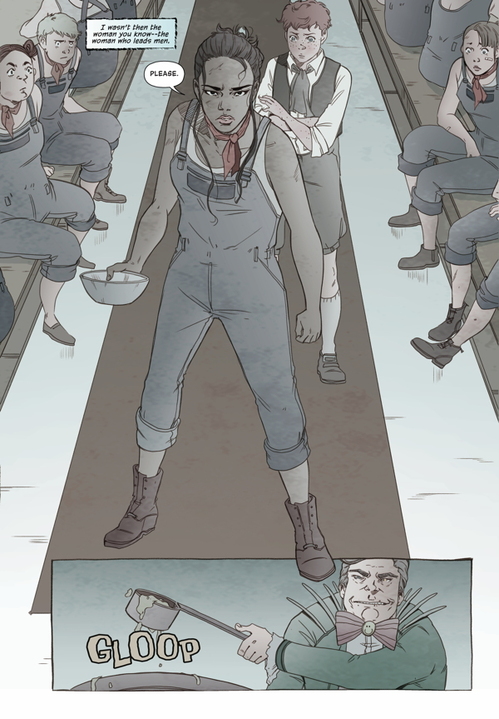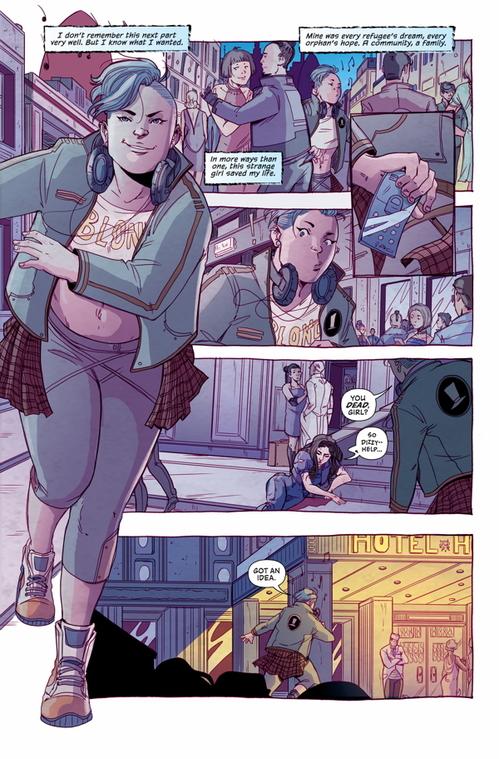By Samantha Puc
Among the vast array of dystopian, utopian, and post-apocalyptic comics on the market right now is a gem created by first-time comic writers Darin Strauss and Adam Dalva. Their new Berger Books/Dark Horse series, Olivia Twist, takes the classic Charles Dickens novel Oliver Twist (as well as elements from his other works) and teleports it into the year 2050, about six months before the world as the characters know it goes up in flames.
The skeleton of the comic is the same as Dickens’ novel: after orphan Olivia escapes a workhouse on her 18th birthday, she’s immediately “rescued” by a character who calls herself the Artful Dodger, a thief among thieves who apparently works with a resistance group called the Esthers. Dodger offers Olivia a safe space to stay while she gets a handle on street living and the two become fast friends, though Olivia has been so sheltered in the workhouse that she has no idea how to interact with the world at large.
In an interview at New York Comic Con, Strauss and Dalva delved into their inspiration for the series, how they altered a classic while still honoring the source material, and what readers can look forward to in future issues.
“We thought [Oliver Twist] lends itself to the medium [of comics] because Dickens wrote in serial, so he really moves toward these big story peaks,” Dalva said, on how the idea to create a comic book came to be.
The writers met when Dalva took a class with Strauss during his graduate studies; they began working on Olivia Twist in 2013, combining their mutual passion for comics and Dickens into one pursuit. At the time, they couldn’t have predicted how timely much of the material would be: the series portrays internment camps in England, outdated technology, and the literal destruction of America, which leaves both the wealthy and the poor stranded in another country (albeit in drastically different living situations).
“I think when people think of Oliver Twist, they think of a lot of the big moments in the book. There’s a lot of stitching in the book that we thought we didn’t need,” Dalva said. “We kept some little moments that we thought were really charming, but mostly we focused on the overall idea of an outsider finding a family of outsiders, but then that family of outsiders might be trying to mislead.”
Strauss noted that both he and Dalva think Oliver Twist is “probably the most recreated tale ever … because it can be mapped onto anything.” With Olivia Twist, they chose to gender-bend and queer the characters in a big way: the oft queer-coded Artful Dodger is canonically interested in Olivia from their first meeting in issue #1. Strauss and Dalva revealed that there’s a love triangle between them and a male character, Charlie, that starts in later issues, making queerness up-front and present on the page.
“We wanted to reflect the world we live in,” Strauss said. “As great as Dickens is — and I think he was great — he was from a different time and a different place where certain things didn’t get heard, so we thought, why not make it more diverse?”
Although the brief introduction to the Esthers in issue #1 doesn’t make this explicit, Dalva said that one of the characters, Cola, is non-binary. These identities aren’t questioned in Olivia Twist, which makes them read like a natural part of the world rather than tokenized diversity.
“We figured since it’s not really dystopic or utopic, it would be like today,” Strauss said. While there is both acceptance of and resistance to queer identities, the Esthers provide “a safe space for people who feel unwelcome in that wider world” where there are internment camps and unsafe situations around every corner.
It’s not just canonical queerness that makes Olivia Twist stand out. In a media landscape that is seemingly obsessed with post-apocalyptic stories, Strauss and Dalva wanted to explore a world “just before the fall.”
Dalva said, “What if we move the story like six months before the real shitshow? What is that world like? We looked around and couldn’t really find anything that did that.”
“If you notice, it’s not utopian or dystopian yet, it’s just a future that seems like our world but maybe turned up to 11,” Strauss said. “By the fourth issue, that will change. So we were like, what if it was a Terminator movie that started before Skynet took over? We haven’t seen that transformation yet. … What if we showed it happening?”
To get their creative juices flowing, Dalva said they turned to academic studies and theories of what might happen in 2050, which informed the world that they created for Olivia Twist. Both he and Strauss are used to writing prose, which is far less collaborative than writing comics; with the help of editor Karen Berger, artist Emma Vieceli, colorist Lee Loughridge and letterer Sal Sipriano, this theoretic world has come to life on the page.
“Emma has been like the gift of this whole thing,” Dalva said. “She’s fantastic.”
“Working with [Emma] and working with Karen — Karen is such a legend and she’s done such cool stuff — working with the two of them has been such a great introduction to the medium,” Strauss added. “I feel like now we’re set up to do whatever we want because we have worked with a great editor and a great artist.”
Dalva said Vieceli knows exactly how to interpret the characters and scenes he and Strauss describe in their scripts, and her familiarity with Dickens’ work (though not as intensive as theirs) provides an extra level of understanding and clarity.
“I love the first time Olivia sees 2050 on the splash page,” Dalva said. “We were thinking about technicolor and we love Lee’s colors. It’s so muted in the workhouse so the explosion of color on the splash is exciting.”
“That was [my favorite panel] too,” Strauss agreed. “I love Emma’s picture of Fagin at the end of [issue #1]. I think that’s a beautiful piece of art, too.”
Loughridge’s colors increase in saturation in future issues, Dalva said. Vieceli’s art style adjusts, too, to accommodate the number of pallets Loughridge uses to portray the mood of each individual scene. According to both Strauss and Dalva, Olivia Twist improves over time, which will surely keep readers engaged as they get closer to learning what has happened to Olivia between the beginning issue #1 and the time from which she’s narrating, post-“Skynet.”
The first Olivia Twist arc “ends with a bang” in issue #4, which concludes the miniseries. Strauss and Dalva hope to continue the story after that big finale with what they’ve plotted beyond the first arc, though there’s been no official word from Berger Books/Dark Horse about a continuation.
Olivia Twist issue #1 is available now. Issue #2 hits shelves Oct. 24, 2018. To keep up with announcements and updates about the series, follow Dark Horse Comics on social media.











Comments are closed.